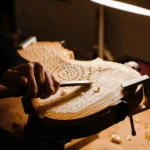How Can You Improve Your Violin Without Buying A New One?
Back to BlogYour instrument doesn’t seem to be giving you all that you wanted, and you are not so sure if you should be buying a new one. But sometimes this is not necessary. You can improve your violin without buying a new violin. Some useful things can help you improve your playing and your instrument without spending extra money.
Violins are valuable instruments, and with reasonable care, their lifespan is very long, decades in most cases. However, they need some repair or adjustments and, believe it or not, these can change your instrument into a new one!
Today, we’ve separated some of our best tips to help you understand what your instrument is trying to tell you; maybe it’s not time to buy a new one yet. But if it is, don’t worry; we will be helping you to figure it out, as well as advising you on how to pick a new violin!
First of all, let’s see what you can do to improve your violin without having to buy a new one.
In everyday care, it’s important to be thorough, but you should also try a few minor adjustments if you feel like something is lacking from your instrument. In general, your violin is a good instrument, but you should know certain things about it to make sure it plays to its full potential. Down below you can check some adjustments and cares that will improve your violin:
- Is there any part of your violin unglued? Changes in humidity levels can cause seams to open and cracks to appear in the instrument; you can identify them by the clear, hollow sounds.
- Keep the bridge at a 90-degree angle. The bridge receives a lot of pressure when the strings are vibrating, so its shape might be twisted. This check improves the resistance needed to support the strings’ pressure. If it happens to have a wrapped bridge, it will make it difficult to transmit the vibrations, making it an unbalanced one. In some cases, it can destabilize the bridge’s foot and cause a break or fall.
- Here is an important tip for you: observe the strings’ height and position. Turn your instrument like this and look at the strings in this way, the D string must be higher than the A string.
- Strings measurements: The distance between the strings must be equal. The distance between the G and E strings is usually around 33mm and 34mm in a violin.
- The ideal position of the bridge is in the middle of the f notch, but of course, you can change the bridge position around the f notches to vary the string length and obtain a different sound, but always keep in mind that the bridge must be at a 90-degree angle.
- Another change that can be done is in the soundpost, by moving its position. However, it must be done by your luthier unless you have the experience and the right tools to do it.
That being said, how do you know if it’s time or not to upgrade your instrument? Let’s understand the signs your violin is telling you.
A good start is by checking your current condition, by that, we mean your violin and your musician skills. While you play, does the instrument voice still please you? We all change all the time and as you evolve with the music world, it is normal to start to have a different perception of the tones and what you seek for your music.
Is the playability allowing you to develop quickly and enabling you to find your way around through practice? The sound of your instrument should sound clear and open; not muffled or closed. Good instruments project their sound easily and evenly. Understand your abilities as a musician to know how can you improve your violin.
As a musician, what are you in need of at the moment?
There are three different kinds of string instruments: solo, orchestral, and chamber music. Each has specific qualities that will determine an appropriate model.
Orchestral and chamber musicians need instruments that are flexible in sound, rich in overtones, and capable of projection. In contrast, soloists have the freedom to play louder since their instruments can withstand being heard over an orchestra.
Every violin player wants to improve, that’s the whole point, and sometimes you might be learning things faster than your violin’s response time. Make sure the violin is not holding you back.
When a violinist reaches a certain level of proficiency, he or she may want to move on to a new violin, a more advanced instrument with more ‘character’ and higher-finish quality. It happens when one mastered the instrument, and now it’s time to look for another challenge. Even though you still can make up your mind, ask for help! Consulting your teacher and colleagues can really clear things, get the right guidance and talk with someone who has experience.
The luthier will also let you know once they have changed all of what was possible. Now, if you have decided that there is no other way for you and your violin, here at Amorim Fine Violins Cremona we have a wide collection of masterpieces that can help you improve your abilities. Sometimes there’s nothing else to improve your violin at the current situation.









